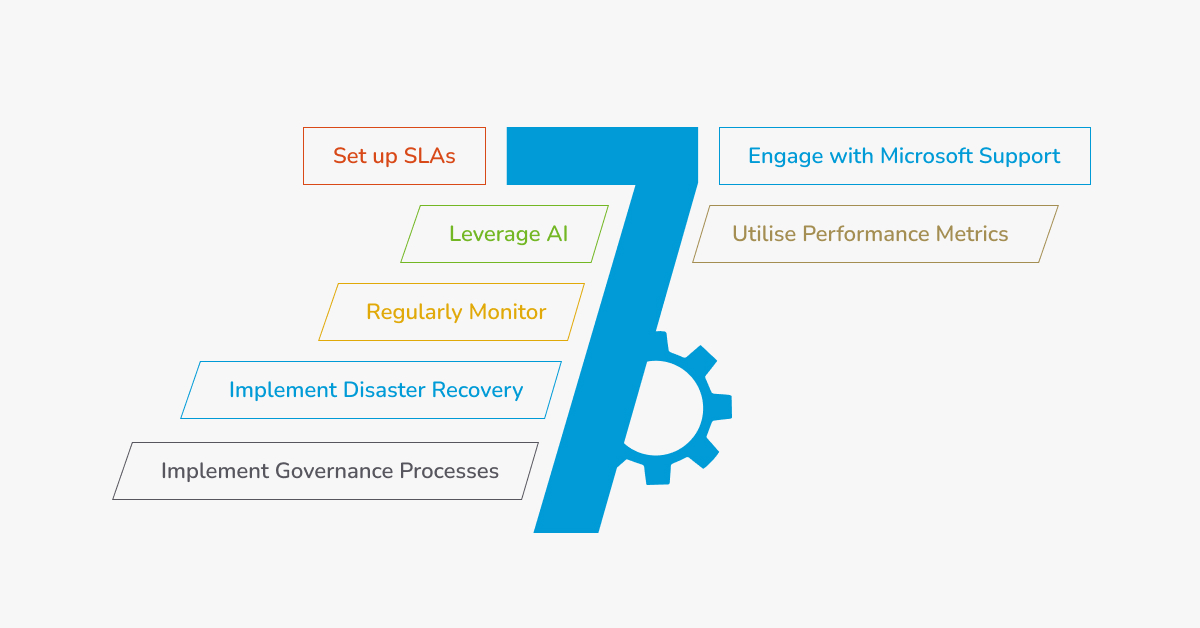In the era of the customer, delivering high-quality service experiences has become a key competitive advantage for businesses across industries.
However, with customer expectations rising, managing service operations can be challenging. That’s where Dynamics 365 for Service Management comes in. With its robust features and capabilities, Dynamics 365 can help companies optimize their service management processes, improve customer satisfaction, and drive business growth.
But simply implementing the tool is not enough; to truly reap the benefits, companies need to follow best practices that enable them to make the most out of Dynamics 365.
In this post, we’ll explore the top 7 best practices for service management in Dynamics 365 that can help your company unlock the full potential of this powerful tool and exceed your customers’ expectations.
Set up SLAs
One of the most important best practices in service management is to set up Service Level Agreements (SLAs) that define service expectations and delivery targets. With Dynamics 365, you can easily create SLAs and track their performance in real time. This helps ensure that your team is meeting customer expectations and provides visibility into areas for improvement.
Here are some steps to follow when setting up SLAs in D365:
- Define your SLA requirements.
- Create SLA records.
- Set up SLA workflows.
- Monitor SLA performance.
- Continuously optimize your SLAs
Leverage AI
AI can help you make better decisions and streamline service processes. Dynamics 365 comes with a range of AI-powered tools, such as chatbots and virtual agents, that can help your team deliver personalized and timely service experiences to your customers.
Here are some ways to leverage AI in D365 services:
- Chatbots for customer service:
- Predictive analytics for sales and marketing:
- Use AI-powered Fraud Detection Tools.
- Use AI-powered personalization tools to tailor your messaging.
- Automated workflows
Regularly Monitor the Health of your D365 Environment
Ensure that you have monitoring tools in place to keep an eye on the performance of your D365 environment. This includes monitoring of system components, database performance, and application performance.
Here are some steps to follow when monitoring the health of your D365 environment:
- Set up monitoring tools to monitor the performance, availability, and usage of your D365 environment.
- Define monitoring metrics and usage metrics, such as the number of users, the amount of data stored, and the frequency of system usage.
- Set up alerts to notify you when specific metrics fall below or exceed predefined thresholds.
- Continuously monitor and analyze the data collected by your monitoring tools.
- Regularly review and update your monitoring metrics to ensure that they are relevant to your organization’s needs.
Implement Disaster Recovery
Implement a disaster recovery plan for your D365 environment. This includes regularly backing up your data, having a plan in place for data recovery, and testing your disaster recovery plan regularly. Here are some steps to follow when implementing disaster recovery:
- Conduct a risk assessment to Identify the potential risks.
- Define the recovery objectives for your D365 environment, including recovery time objectives (RTOs) and recovery point objectives (RPOs).
- Develop a disaster recovery plan for backing up data, restoring data, and testing the recovery process.
- Choose a disaster recovery solution that meets your organization’s needs.
- Regularly test your disaster recovery plan to ensure that it is effective.
Utilise Performance Metrics
Regularly monitor performance metrics to identify any areas that need improvement. This includes tracking key performance indicators such as response times, error rates, and system availability. You can follow these steps while utilizing performance metrics:
- Define performance metrics.
- Monitor and analyze data.
- Establish performance benchmarks.
- Identify areas for improvement.
- Continuously monitor and adjust.
Implement Governance Processes:
Implement governance processes to ensure that your D365 environment is being used in a compliant and controlled manner. This includes monitoring usage, setting usage policies, and enforcing compliance regulations.
- Define governance policies that are tailored to your organization’s needs and objectives.
- Establish clear roles and responsibilities for managing your D365 environment.
- Implement security controls such as multi-factor authentication, data encryption, and intrusion detection and prevention systems.
- Manage access control to ensure that users have appropriate levels of access to data and functionality.
- Regularly monitor compliance with relevant regulations and standards, such as GDPR or HIPAA.
- Implement processes to manage risk assessments, identify and prioritize risks, and implement risk mitigation strategies.
- Establish change management processes to ensure that changes to your D365 environment are properly tested, approved, and documented.
Engage with Microsoft Support.
Engage with Microsoft support to ensure that you are getting the most out of your D365 environment. This includes regularly engaging with Microsoft support to troubleshoot issues and get guidance on best practices, and:
- Familiarize yourself with the support options available such as online documentation and community forums, as well as paid support options, such as technical support and Premier Support.
- Take advantage of Microsoft’s self-service resources to help troubleshoot issues and learn more about D365.
- If you are unable to resolve an issue using self-service resources, contact Microsoft technical support.
- If your organization has purchased Premier Support, engage with your assigned technical account manager (TAM) to receive personalized support and guidance.
- When engaging with Microsoft support, collaborate with the Microsoft engineers to effectively troubleshoot issues and find solutions.
- Stay up to date on product updates and releases to ensure that your environment is properly maintained and supported.
Conclusion
By following the best practices outlined above, such as regularly monitoring the health of your environment, leveraging AI, and engaging with Microsoft support, you can optimize your D365 deployment to meet your business needs and objectives.
Implementing these best practices can also help you avoid potential risks and pitfalls that can arise when managing complex technology platforms. By taking a proactive approach to D365 services management, you can ensure that your organization is well-equipped to adapt and thrive in an increasingly digital business environment.



